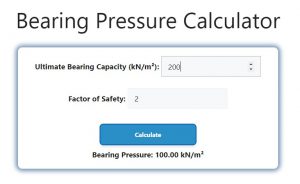About Bearing Pressure Calculator (Formula)
The Bearing Pressure Calculator is an essential tool for civil engineers and construction professionals tasked with determining the safe bearing pressure for foundations. Knowing the bearing pressure helps ensure that structures are built on a solid foundation, minimizing the risk of settlement or failure. This calculator takes into account the ultimate bearing capacity (UBC) of the soil and a safety factor to provide a reliable estimate of the bearing pressure.
Formula
The formula used for calculating bearing pressure is: Pbearing = Ultimate Bearing Capacity / Factor of Safety. In this formula, Pbearing represents the safe bearing pressure, UBC is the ultimate bearing capacity of the soil, and FS is the factor of safety, which accounts for uncertainties in load and soil behavior.
How to Use
To use the Bearing Pressure Calculator, follow these simple steps:
- Determine Ultimate Bearing Capacity (UBC): This value is typically obtained through soil testing or geotechnical reports. It represents the maximum load the soil can support without failure.
- Select Factor of Safety (FS): The factor of safety is a predetermined value that accounts for uncertainties and potential variations in load. Common values range from 1.5 to 3, depending on the project’s requirements and soil conditions.
- Input Values: Enter the UBC and FS values into the calculator.
- Calculate Bearing Pressure: Execute the calculation to obtain the safe bearing pressure (Pbearing). The calculator will apply the formula to provide you with the result.
Example
Suppose a construction project has the following parameters:
- Ultimate Bearing Capacity (UBC): 200 kPa
- Factor of Safety (FS): 2.0
Using the formula:
Pbearing = UBC / FS
Pbearing = 200 kPa / 2.0
Pbearing = 100 kPa
Thus, the safe bearing pressure for the foundation in this example is 100 kPa.

FAQs
1. What is bearing pressure?
Bearing pressure is the pressure exerted by the foundation on the soil beneath it, determining the soil’s load-bearing capacity.
2. Why is a factor of safety important?
The factor of safety accounts for uncertainties in soil behavior, load variations, and construction practices, ensuring structural safety.
3. How is the ultimate bearing capacity determined?
The ultimate bearing capacity can be determined through soil testing, including plate load tests or by using empirical formulas based on soil properties.
4. What happens if the bearing pressure exceeds the safe limits?
Exceeding the safe bearing pressure can lead to soil failure, resulting in settlement, tilting, or even collapse of the structure.
5. How do I choose an appropriate factor of safety?
The factor of safety depends on the project type, soil conditions, and potential risks. Consult engineering standards or guidelines for specific recommendations.
6. Can I use this calculator for any type of foundation?
Yes, the Bearing Pressure Calculator can be used for various foundation types, including shallow and deep foundations.
7. How often should soil testing be conducted?
Soil testing should be performed for every new site, especially if soil conditions are unknown or vary significantly.
8. Is a higher factor of safety always better?
While a higher factor of safety increases reliability, it may also lead to larger foundation sizes and increased costs. Balance safety with economic considerations.
9. Can soil properties change over time?
Yes, soil properties can change due to factors such as moisture variation, loading conditions, and environmental influences, which may require re-evaluation.
10. How do I know if my foundation is stable?
Monitoring settlement and conducting periodic inspections can help assess the stability of a foundation over time.
11. What are common types of foundations?
Common types include shallow foundations (like footings) and deep foundations (like piles).
12. How does soil type affect bearing capacity?
Different soil types have varying load-bearing capacities. Cohesive soils generally have higher capacities than granular soils.
13. What role does moisture content play?
Moisture content can significantly affect soil strength and bearing capacity, especially in clay soils.
14. Are there standards for bearing pressure calculations?
Yes, engineering standards such as those from the American Society of Civil Engineers (ASCE) provide guidelines for safe bearing pressure calculations.
15. Can the calculator be used for large structures?
Yes, the calculator can be applied to large structures, but it’s essential to consider the cumulative effects of loads on soil.
16. What additional factors should I consider in foundation design?
Consider factors such as lateral loads, environmental conditions, and potential for seismic activity.
17. Is a geotechnical engineer necessary for all projects?
For larger or more complex projects, consulting a geotechnical engineer is advisable to ensure proper foundation design.
18. How do you calculate the load on the foundation?
The load can be calculated by considering the total weight of the structure, including live loads and dead loads.
19. What is the typical range for factors of safety?
Factors of safety typically range from 1.5 to 3, depending on project requirements and soil conditions.
20. Can the Bearing Pressure Calculator replace professional advice?
While the calculator is a valuable tool, it should not replace professional judgment or consultation with qualified engineers.
Conclusion
The Bearing Pressure Calculator is a crucial tool for ensuring that foundations are designed safely and effectively. By understanding how to calculate safe bearing pressures using the ultimate bearing capacity and a factor of safety, construction professionals can optimize their designs and contribute to the overall stability of structures. Proper use of this calculator, along with thorough soil testing and adherence to engineering standards, ensures successful and safe construction projects.